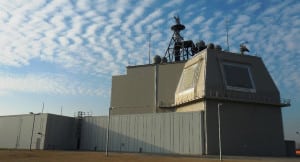Japan decided to suspend the deployment of the two Aegis Ashore missile defense systems due the technical and cost issues, Defense Minister Taro Kono said Monday.
“In view of the cost and [more] time [needed] for the deployment, we will halt the process,” local Kyodo News reported Kono told reporters.

Aegis Ashore is a land-based variant of the U.S. Navy’s Aegis Weapons System that targets medium and intermediate-range ballistic missiles. Japan currently fields several ships with the Aegis system.
Kono underscored it is difficult to ensure the Aegis Ashore’s Standard Missile (SM)-3 Block IIA interceptor rocket booster would land in a Japan Self-Defense Forces training area or the sea as promised without hardware modifications.
Kono said talks with the U.S. led the government to conclude the safety of the population around the chosen sites could not be guaranteed and software modifications alone would not resolve the technical challenges.
“For the time being, we’ll maintain our missile defense capability by Aegis-equipped destroyers,” Kyodo News reported Kono said.
In 2017, Japan’s government announced it planned to expand missile defenses, including Aegis Ashore systems (Defense Daily, Aug. 18, 2017).
Then, in 2018, Japan’s Ministry of Defense said it selected Lockheed Martin’s [LMT] Long Range Discrimination Radar (LRDR) for its Aegis Ashore sites over Raytheon Technologies’ [RTX] SPY-6 Air and Missile Defense Radar (AMDR). The LRDR for the two sites was expected to cost about $1.2 billion alone (Defense Daily, July 30, 2018).
In 2018, local media reported the Aegis Ashore sites were expected to be operational by 2023, but now Kyodo News reported the sites were expected to be in operation by fiscal year 2025 at the earliest.
Last January, the State Department approved a possible $2.15 billion Foreign Military Sale for Japan to buy two Aegis Weapons Systems for the Aegis Ashore sites (Defense Daily, Jan. 29, 2019)
Kyodo News noted the Defense Ministry estimates the two systems to cost over $4 billion including a 30-year service life with maintenance costs, while the government has already spent about $1 billion.
The Japanese government previously proposed basing sites in the northern prefecture of Akita and the southern prefecture of Yamaguchi, but faced opposition from both citizens and local officials.
The government also conducted an erroneous geographical survey in selecting the Akita site while new survey results were repeatedly pushed back due to the COVID-19 pandemic.
The only fully operational Aegis Ashore site is at Deveselu Air Base, Romania, and it features the Aegis ship-style deckhouse, an AN/SPY-1 radar, Mark 41 Vertical Launching System, and SM-3 Block IB interceptors. Interceptors are due to upgrade to the SM-3 IIA missiles.
The U.S. tests and evaluates Aegis Ashore systems at the Aegis Ashore Missile Defense Test Complex at the Pacific Missile Range Facility, Kauai, Hawaii.
The second European Aegis Ashore site in Poland has been repeatedly delayed due to various construction issues. In March, Missile Defense Agency Director Vice Adm. Jon Hill told lawmakers the Defense Department is refusing payments to the construction contractor amid delays and may outright cancel the contract (Defense Daily, March 13).